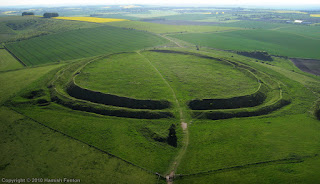Llandewi Aberarth, church with hill fort above it
Llandewi Aberarth
In previous blog posts, I proposed that the name Arthur or Artorius was a Latin decknamen on an Irish name meaning "Bear-king", and that the king in question was Ceredig son of Cunedda of Ceredigion, known in the Anglo-Saxon Chronicle as Cerdic of the Gewessei. Furthermore, I had theorized that the bear personal names in the Ceredigion genealogy could best be explained by the fact that in mid-Ceredigion there was an Arth or 'Bear' River, right next to the Afon Aeron. Aeron or *Agrona, 'Slaughter goddess', suggested to me that the "Bear" might also have been a divine river. If so, the bear names of Ceredig and his descendants were due to the fact that the ruling center of the kingdom was somewhere on the Afon Arth.
Subsequent research to find this ruling center of Ceredig/Arthur revealed only two possible sites. One is Dineirth, and the other Llandewi Aberarth. What I needed to determine is which of the two places showed potential for sub-Roman or early medieval habitation.
Subsequent research to find this ruling center of Ceredig/Arthur revealed only two possible sites. One is Dineirth, and the other Llandewi Aberarth. What I needed to determine is which of the two places showed potential for sub-Roman or early medieval habitation.
According to Frances Foster, Archive & Library Assistant, Archive and Library Team, Royal Commission on the Ancient and Historical Monuments of Wales:
"I have checked the information we hold on the above site [Dineirth] and have not found any mention of Roman occupation or activity. The description on the Ordnance Survey National Archaeological Record card states that the site was originally a Clare Castle (Richard de Clare) founded prior to 1136.
In R.E. Kay’s description he suggests that ‘the first Norman adventurers may have found the earthworks of a small promontory fort at their chosen site which they heightened and strengthened’. He also says that ‘the Castle of Dineirth (or Dinarth) was probably founded by Richard de la Mare and follower of Richard de Clare in 1110.
Again in Cadw’s scheduling description there is no mention of sub-Roman occupation of this site."
Llandewi Aberarth may be different. On the possible ruling center of the kingdom of Ceredigion, Toby Driver, Senior Investigator (Aerial Survey) for the RCAHMW and author of HILLFORTS OF CARDIGAN BAY, says
Llandewi Aberarth may be different. On the possible ruling center of the kingdom of Ceredigion, Toby Driver, Senior Investigator (Aerial Survey) for the RCAHMW and author of HILLFORTS OF CARDIGAN BAY, says
"I would find it very difficult to decide on a place for a ‘ruling centre’, although a coastal position may be better connected than one inland [emphasis mine]... The Arth has a very restricted catchment, and I am not aware of any other major archaeological sites along its reaches. That said the presence of a major castle at Dinerth, the Viking hog-back stone at Llanddewi-Aberarth and the coastal hillfort, along with the ancient fish traps on the foreshore at Aberarth, all add up to a high concentration of interesting sites. Certainly it is an interesting locale along the Cardigan Bay coastline."
Here is the description of the hill fort at Llandewi Aberarth from COFLEIN (http://www.coflein.gov.uk/en/
Here is the description of the hill fort at Llandewi Aberarth from COFLEIN (http://www.coflein.gov.uk/en/
NPRN 419561
Map Reference SN46SE
Grid Reference SN47616337
Unitary (Local) Authority Ceredigion
Old County Cardiganshire
Community Dyffryn Arth
Type of Site DEFENDED ENCLOSURE, HILLFORT
Broad Class Defence
Period Iron Age
Site Description The church of St Davids sits below and to the east of the triangular summit of a prominent coastal hill which has been suggested as a possible Iron Age hillfort by the Dyfed Archaeological Trust, citing both its general shape and the presence of Bronze Age finds just below the summit.
Royal Commission aerial photographs of the hilltop taken during the drought summer of 2013 (on 12th July) appear to clarify parched banks and ditches of a large triangular or pear-shaped hilltop enclosure, generally following the lines of present field boundaries and walls but of more massive construction, suggesting a prehistoric origin. This main hilltop enclosure measures approximately 278m x 110m, enclosing 2.7 hectares. On the east side of the ridge is a discrete, smaller rectangular earthwork enclosure within the larger one, following the line of the ridge but with a rounded southern end, into which the cemetery of St Davids Church encroaches. It is possible that this is also a prehistoric or early medieval enclosure [emphasis mine], perhaps representing a first phase, or a contraction of a larger site. Recorded during RCAHMW aerial reconnaissance (frames AP_2013_2951-53) and also during winter conditions on 26th February 2014, highlighting the earthworks (frames AP_2014_0311-12, 319, 324-5).
If I'm right about the Arth River being the location of the Dark Age ruling center belonging to Ceredig and his descendants, then the hill fort at Llandewi Aberarth must be considered the primary contender. Of course, only excavation of the site, and in particular of the smaller enclosure on the east side of the ridge, would be able to demonstrate whether sub-Roman or early medieval habitation occurred there.
If I'm right about the Arth River being the location of the Dark Age ruling center belonging to Ceredig and his descendants, then the hill fort at Llandewi Aberarth must be considered the primary contender. Of course, only excavation of the site, and in particular of the smaller enclosure on the east side of the ridge, would be able to demonstrate whether sub-Roman or early medieval habitation occurred there.
I'm still trying to procure at least a preliminary report on the hill fort at Llandewi Aberarth, but so far have had no success obtaining such a document. It may not exist. However, if such a report is forthcoming, I will immediately make it available here.



















